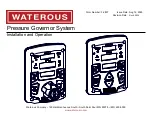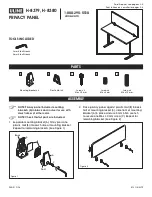
>@9
Multitone Audio Test System
User Manual
V 3.32
19 / 71
Only frequencies with an integral multiple of
∆
f may be defined as
signal bins (see below) of
a multitone burst.
Example
Blocklength = 512 @ 48kHz sampling rate
⇒
∆
f = 93.75Hz
⇒
available frequencies =
n * 93.75Hz (n = integral number)
Bins
The frequencies, that may be transmitted in a multitone burst, are called
bins. For a better
understanding, three types of bins have been introduced.
•
Signal bins are those bins (frequencies) that actually build the multitone signal.
•
Even bins are all the bins (frequencies) that emerge from
Equation 3
, i.e. the frequencies
that may be used as signal bins in a multitone signal.
•
Odd bins are an effect the internal FFT computation of
>@9
. They represent all bins
halfway between the even bins, i.e. as if the frequency spacing would equal
∆
f/2.
The subsequent relations indicate the min. and max. available frequencies (
bins) in a
multitone signal at 8kHz / 48kHz sampling rate (
f
s
).
{
}
f
f
Hz may be generated only
min
=
≥
∆
20
Equation 4 Minimum Signal Bin Frequency
{
}
f
f
kHz
f
kHz may be displayed
max
*
=
≤
∆
∆
20
20
Equation 5 Maximum Signal Bin Frequency
Besides the above equations there are no other constraints for the definition of a multitone
signal. This means you can use any bin representing a frequency below or equal to 20kHz
as a signal bin. It is up to the operator what the intention of the signal bins is. Please refer
also to chapter
Signal Table
.
Phase / Crest Factor Optimization
In order to achieve a low Crest factor, RT-EVAL – an evaluation PC-program provided free
of charge by NEUTRIK - offers a special feature that allows to optimize the phases of any
multitone signal. The results can be loaded directly from or back into the
>@9
Generator.
Low Crest factors are important for two reasons. First, the peak level of the multitone signal
raises the necessary input range for the analysis and thereby reduces sensitivity for the low-
level signal components. Second, the low energy content of a multitone signal with high
Crest factor may barely stimulate the DUT.
A non-optimized multitone signal may show Crest factors of up to 10 (20dB), while with a
proper minimization algorithm, Crest factors as low as ~2 (6dB) can be found. This
difference of 14dB can directly enhance or decrease the dynamic range of the analyzing
system.
















































